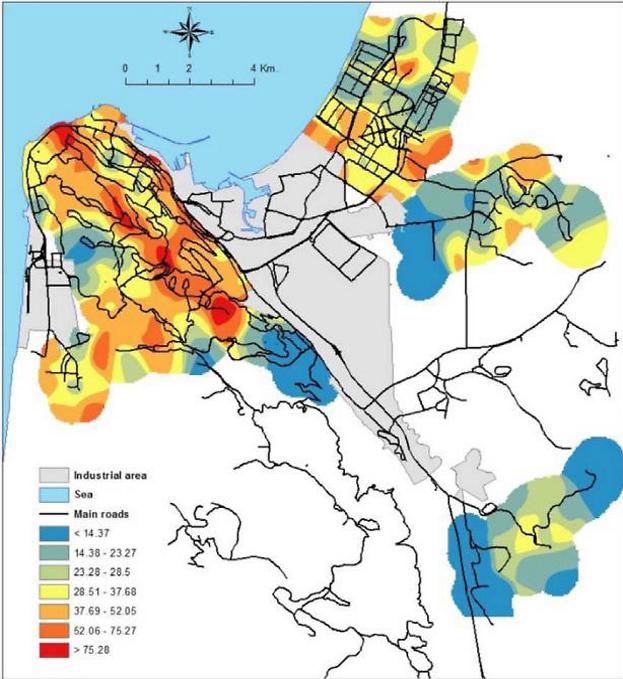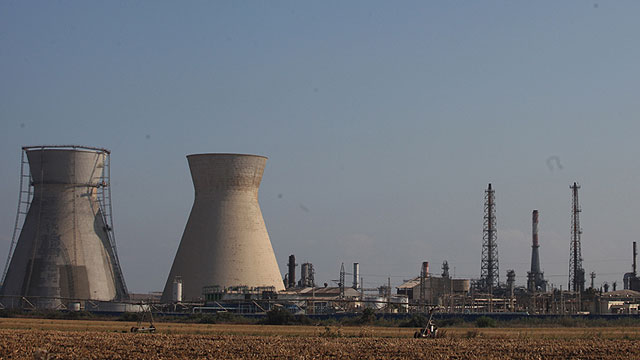
Health, Environmental Protection Ministries reject study on Haifa pollution
State-appointed scientific committee determines research methods used in study that pointed to a connection between air pollution in the Haifa Bay area and cancer rates among the residents were inadequate to reach the conclusions drawn.
A scientific committee was tasked by the Health and Environmental Protection Ministries with examining the results of a study that pointed to a connection between air pollution in the Haifa Bay area and cancer rates among the residents. This committee has determined that the research methods used were inadequate to reach the conclusions drawn.
"These findings cannot form a basis to assessing the morbidity rates or to drawing a connection between air pollution and the morbidity in the Haifa Bay area," the committee's report determined.
The large-scale study, which made headlines at the beginning of the year and caused a public outcry, was funded by the Haifa District Municipal Association for Environmental Protection and from fees paid by the polluting factories.
The study, conducted by researchers from Haifa University, examined six sub-topics: The incidence of lung cancer and non-Hodgkin's lymphoma; the health of infants; the incidence of asthma in children; the incidence of asthma among new IDF recruits; biological monitoring of the impact of air pollution; and air quality data.
The researchers collected data on the health condition of the residents of the area, specifically focusing on cancer, heart diseases and lung diseases. These data were presented in conjunction with data on the air quality in the Haifa Bay area. Researchers also compared morbidity rates in Haifa to those in Tel Aviv and Hadera.
They found that babies born in areas of Haifa suffering from high levels of pollution have lower-than-average weight and head circumference, with measurements 20-30 percent less than babies from other areas in the city.
In addition, researchers found that rates of lung cancer and lymphoma in those areas are up to five times the national average.
The study points to three main areas with high rates of morbidity: Kiryat Haim and Kiryat Bialik, southeast Kiryat Tivon, and the Carmel range—the side facing the industrial zone.

The state-appointed scientific committee, headed by Prof. Siegal Sadetzki, examined the research methods used in the first year of the study. After scrutinizing the report, meeting with the researchers and discussing their findings, the committee unanimously determined that that the research methods used in the first year were inadequate to reach the conclusions drawn. The committee can therefore disregard the findings heretofore presented.
According to the committee, the study is plagued with fundamental methodological problems that raise doubt as to the credibility and validity of the data and that of the methods used by the researchers. This therefore also raises doubts regarding the validity and significance of the results presented.
The committee determined that while the research methods could point to changes over time in the concentration of pollutants by comparing different cities, they cannot be used to discerning the differences in the concentration of pollutants in different areas within Haifa.
In addition, the committee pointed to the fact the team of researchers did not include an expert on air quality, while the study itself lacked an assessment of exposure to this air quality.
The research team said in response, "The full report, led by researchers at the University of Haifa, was written by leading experts in the country, including experts from the University of Haifa, the Technion, Tel Aviv University and Ben-Gurion University.
"The report itself consists of various studies, conducted by researchers from various universities, and based on external data repositories from several sources—the Health Ministry, the Environmental Protection Ministry and the IDF. Although the study includes various different researchers, studies and databases, all of the results are consistent, and there is a high correlation among the various studies regarding the 'hot spots' of morbidity discovered.
"Moreover, another study based on the methodology of the report was recently published in the Environmental Research journal, which publishes only a few dozen studies every year that have been carefully examined and selected from among hundreds submitted to the journal. This indicates that it is a leading study in its field, and that the methodology used by the researchers meets international scientific standards."
Meanwhile, the Haifa Municipality said in response, "The municipality accepts verbatim the statement by the Environmental Protection and Health Ministries that rejects the research methods, as well as the interim results released to date.
"In the coming days, we will examine the issue and work alongside the Environmental Protection and Health Ministries to promote an alternative research, comprehensive and professional, to clarify the data on the quality of air in the area."












